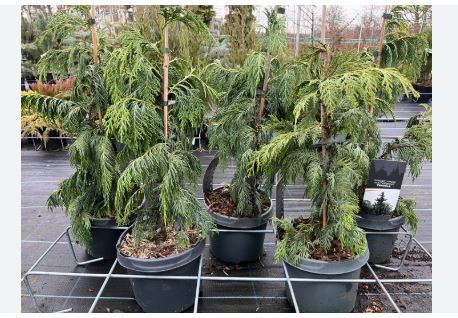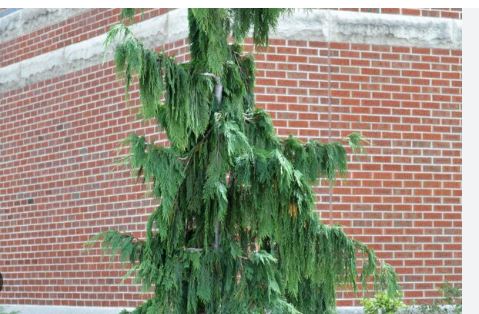
The Nootka Cypress (Callitropsis nootkatensis), also known as Alaska Cedar or Yellow Cedar, is a striking evergreen conifer revered for its graceful, weeping foliage and resilience in cool, wet climates. Native to the Pacific Northwest, this tree is a cornerstone of coastal forests, valued for its durable wood, ornamental beauty, and ecological significance.
Its pendulous branches and adaptability make it a favorite for gardens, parks, and restoration projects, while its cultural importance to Indigenous peoples adds depth to its legacy. In this detailed guide, we explore the botanical classification, origin, identifying characteristics, habitat, distribution, USDA hardiness zones, uses, and fascinating facts about the Nootka Cypress.
Botanical Classification, Origin and Native Area
The Nootka Cypress, scientifically named Callitropsis nootkatensis, belongs to the Cupressaceae family, which includes cypresses, junipers, and cedars. Previously classified under Chamaecyparis or Cupressus, it was reclassified into the genus Callitropsis based on genetic studies distinguishing it from other cypresses.
The species name nootkatensis refers to Nootka Sound on Vancouver Island, part of its native range. As a gymnosperm, it produces cones rather than flowers, and its closest relatives include the Monterey Cypress (Hesperocyparis macrocarpa), with which it hybridized to create the Leyland Cypress (Cuprocyparis leylandii). Cultivars like ‘Pendula’ and ‘Green Arrow’ highlight its weeping forms, enhancing its horticultural appeal.
The Nootka Cypress is native to the Pacific Northwest of North America, with its range extending from southern Alaska through coastal British Columbia, Washington, and Oregon, reaching as far south as northern California. It thrives in the cool, moist climates of the coastal mountains and islands, often at elevations from sea level to 6,000 feet.
Indigenous peoples, such as the Haida, Tlingit, and Nuu-chah-nulth, have long valued the tree for its wood, used in carving, construction, and totem poles, and its bark for weaving. Fossil records suggest that Callitropsis species were widespread during warmer prehistoric periods, with the Nootka Cypress adapting to the region’s wet, temperate conditions over millennia.
Identifying Characteristics

The Nootka Cypress is a medium to large conifer, typically growing 60–90 feet tall in the wild, though cultivated specimens often reach 20–40 feet, with a spread of 10–20 feet. Its distinctive weeping branches create a graceful, drooping silhouette, particularly in cultivars like ‘Pendula’. The foliage consists of soft, scale-like leaves, arranged in flattened, fern-like sprays, varying from dark green to bluish-gray, with a slightly coarse texture.
The leaves emit a pungent, resinous scent when crushed. The bark is grayish-brown, fibrous, and peels in thin, vertical strips, adding texture. The tree produces small, woody cones (0.3–0.5 inches), spherical and brown, with 4–6 scales and small, winged seeds. Its pendulous form, dense foliage, and conical to irregular crown make it a striking landscape feature.
Habitat
In its native habitat, the Nootka Cypress thrives in cool, moist, coastal environments, often in temperate rainforests, montane forests, and boggy areas. It prefers well-drained, acidic soils (pH 4.5–6.5), typically loamy or rocky, but tolerates poor, wet soils, including those with high organic content.
The tree requires full sun to partial shade, benefiting from the region’s frequent fog and high humidity, and is highly tolerant of salt spray and wind, making it ideal for coastal sites. It often grows alongside western hemlock, Sitka spruce, and red cedar, contributing to forest ecosystems by stabilizing soil and providing shade. In cultivation, it adapts to urban and suburban settings, provided drainage is adequate and extreme heat is avoided.
Distribution
The Nootka Cypress is naturally distributed along the Pacific Northwest coast, from the Kenai Peninsula in Alaska to the Siskiyou Mountains in northern California, with significant populations on Vancouver Island, the Cascade Range, and the Olympic Peninsula. Its range is limited to cool, wet climates, where it forms pure stands or mixed forests at low to mid-elevations.
Due to its ornamental value, it has been planted widely in temperate regions, including the northeastern United States, Europe (especially the UK and Scandinavia), and parts of New Zealand and Australia. It is not invasive, as it rarely self-seeds aggressively, but its cultivation has expanded its presence globally. Conservation efforts focus on protecting its native forests, threatened by logging and climate change.
USDA Hardiness Zones
The Nootka Cypress thrives in USDA Hardiness Zones 4–8, tolerating minimum temperatures from -30°F to 10°F (-34°C to -12°C). It is best suited to cool, temperate climates with mild summers and wet winters, similar to its Pacific Northwest origins.
In Zone 4, young trees may require protection from harsh frost or drying winds, while in warmer zones (7–8), they flourish with minimal care, provided moisture is adequate. Its tolerance for cold, wind, and salt spray makes it ideal for northern and coastal gardens, though it may struggle in hot, arid, or humid subtropical climates.
Uses
The Nootka Cypress is a versatile tree with significant ornamental, ecological, and cultural applications. In landscaping, its weeping foliage and compact cultivars, such as ‘Green Arrow’ or ‘Pendula’, make it a dramatic specimen tree, hedge, or accent in gardens, parks, and urban settings. Its dense foliage provides privacy, wind protection, and noise reduction, ideal for coastal or exposed sites.
Ecologically, it stabilizes soil in wet areas, supports wildlife (e.g., birds nesting in its branches), and contributes to forest biodiversity. The tree’s durable, aromatic wood is highly valued for construction, furniture, boat-building, and carving, particularly by Indigenous artisans for totem poles and cultural artifacts. Its wood is also used for outdoor applications like decking due to its rot resistance.
In urban environments, it improves air quality and mitigates stormwater runoff. Culturally, the Nootka Cypress holds spiritual significance for Pacific Northwest Indigenous communities, symbolizing strength and connection to the land. Its versatility and beauty make it a cherished species in both traditional and modern contexts.
Fun Facts
The Nootka Cypress is steeped in fascinating trivia that highlights its unique character. Despite its name, it is not a true cypress but a distinct conifer, reclassified into Callitropsis to reflect its genetic lineage, a testament to evolving taxonomic science. Some Nootka Cypresses in the wild are over 1,000 years old, with massive trunks and gnarled forms that tell stories of centuries in rugged coastal forests.
The tree’s wood was historically used by the Nuu-chah-nulth people to carve intricate masks and canoes, showcasing its cultural importance. Its hybrid offspring, the Leyland Cypress, is one of the world’s most planted trees, yet the Nootka Cypress itself remains a slower-growing, more refined species.
The tree’s ability to thrive in boggy, low-oxygen soils is due to specialized root adaptations, allowing it to outcompete other conifers in challenging environments. Additionally, its foliage turns slightly bronze in winter in colder climates, adding seasonal interest. The Nootka Cypress is also a survivor, with some populations enduring glacial periods, making it a living link to Earth’s ancient past.
Cultivation of The Nootka Cypress (Callitropsis nootkatensis)
Cultivating the Nootka Cypress (Callitropsis nootkatensis), also known as Alaska Cedar or Yellow Cedar, is a rewarding endeavor for gardeners and landscapers seeking a graceful, evergreen conifer with weeping foliage and resilience in cool, moist climates. Native to the Pacific Northwest, this tree’s pendulous branches, aromatic wood, and adaptability make it ideal for ornamental gardens, coastal landscapes, or ecological restoration projects.
While relatively low-maintenance, proper care ensures its health and longevity, particularly in preventing disease and supporting its slow to moderate growth. Below are 13 key points to guide the successful cultivation of Nootka Cypress, promoting vigorous growth and enduring beauty in suitable environments.
- Climate Suitability: Nootka Cypress thrives in USDA Hardiness Zones 4–8, tolerating minimum temperatures from -30°F to 10°F (-34°C to -12°C). It prefers cool, temperate climates with mild summers and wet winters, similar to its Pacific Northwest origins. In Zone 4, protect young trees from severe frost, while in warmer zones, ensure adequate moisture to prevent heat stress.
- Site Selection: Choose a location with full sun to partial shade, receiving at least 4–6 hours of direct sunlight daily, to promote dense foliage and a graceful form. Full sun is ideal, but the tree tolerates light shade, especially in hotter climates. Ensure the site accommodates its mature size (20–40 feet tall in cultivation, 10–20 feet wide) and offers protection from extreme heat.
- Soil Requirements: Plant in well-drained, acidic to neutral soil (pH 4.5–6.5), such as loamy, rocky, or organic-rich types. Nootka Cypress tolerates poor, wet soils, including boggy conditions, but requires good drainage in upland settings to prevent root rot. Amend heavy clay soils with sand or organic matter (e.g., compost) to improve aeration and drainage.
- Planting Time: The optimal planting seasons are early spring or fall, allowing roots to establish before summer heat or winter cold. Dig a hole twice as wide and as deep as the root ball, positioning the root collar at ground level. Backfill with native soil, tamp gently, and water thoroughly to settle the roots and eliminate air pockets.
- Watering Needs: Water young trees regularly (1–2 times weekly) for the first 1–2 years to establish a strong root system, keeping soil consistently moist but not waterlogged. Once established, Nootka Cypress is moderately drought-tolerant but thrives with consistent moisture, especially in dry or hot conditions. Avoid overwatering in poorly drained soils to prevent fungal issues.
- Mulching: Apply a 2–3 inch layer of organic mulch (e.g., pine bark, wood chips) around the base, extending to the drip line but keeping it 2 inches from the trunk. Mulch conserves moisture, regulates soil temperature, and suppresses weeds, supporting young trees in variable climates. Replenish mulch annually to maintain its effectiveness.
- Fertilization: Fertilize sparingly, as Nootka Cypress thrives in low-nutrient soils. In early spring, apply a balanced, slow-release fertilizer (e.g., 10-10-10) to young trees at half the recommended rate to encourage growth without causing weak, rapid shoots. Mature trees rarely need supplemental feeding in fertile soils, relying on natural nutrients.
- Pruning: Prune minimally to maintain shape or remove dead, damaged, or crossing branches, ideally in late winter or early spring before new growth begins. Use clean, sharp shears for precise cuts. The tree’s natural weeping form, especially in cultivars like ‘Pendula’, requires little shaping, but light trimming can enhance structure for hedges or specimens.
- Pest and Disease Management: Monitor for pests like spider mites, aphids, or spruce budworms, treating infestations with insecticidal soap or neem oil. Nootka Cypress is relatively disease-resistant but may develop root rot in poorly drained soils or heart rot in older trees. Ensure proper drainage, avoid overhead watering, and space trees to improve air circulation and reduce fungal risks.
- Spacing: Space trees 10–15 feet apart to accommodate their mature spread (10–20 feet), ensuring adequate sunlight and air circulation to prevent disease. For hedges or windbreaks, plant 6–8 feet apart to create a dense barrier, particularly with compact cultivars like ‘Green Arrow’. Consider their height (20–40 feet in cultivation) when planting near structures.
- Wind Protection: Young Nootka Cypresses, with shallow roots, are susceptible to windthrow in exposed coastal or mountainous areas. Stake newly planted trees for the first 1–2 years using flexible ties to allow slight trunk movement, which strengthens roots. Remove stakes once established to promote independent growth and stability.
- Winter Care: In Zones 4–5, protect young trees from winter burn by wrapping them in burlap or applying an anti-desiccant spray to foliage. Water adequately before winter to prevent dehydration, as evergreens lose moisture through needles in cold, dry conditions. Mature trees are highly cold-hardy and require minimal winter care, even in northern climates.
- Long-Term Growth: Nootka Cypresses grow slowly to moderately (1–2 feet per year), reaching 20–40 feet in cultivation (up to 90 feet in the wild) with a lifespan of centuries. Their weeping foliage, salt tolerance, and durability make them ideal for coastal gardens, specimen planting, or ecological restoration. Regular monitoring ensures health and structural integrity, especially in urban or disease-prone areas.